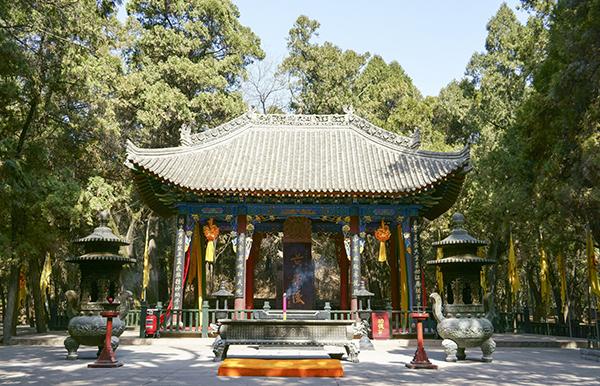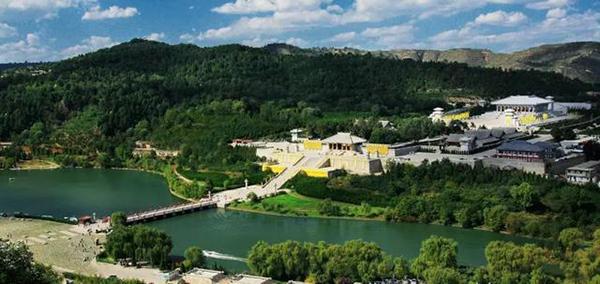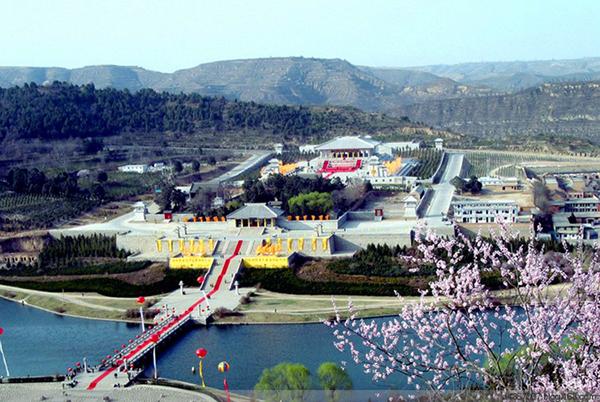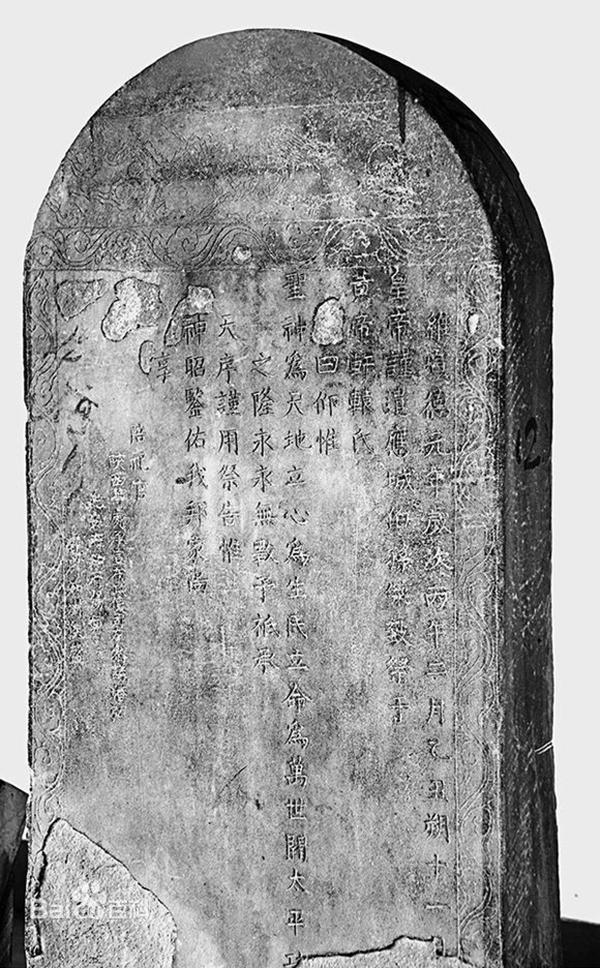In order to deeply explore the values in history and culture, the Qingming Festival Huangdi Ceremony in Xuanyuan will be held in the Hundred Days of 1898. In 2018, the Qingming "Huangdi Culture Academic Exchange Conference" was held in Xi ‘an People’s Building from April 2 to 6. Scholars and professors from Tsinghua University, Nanjing University, Northwest University, Taiwan Province University of Politics, Taiwan Fu Jen Catholic University and other institutions discussed the origin of Huangdi culture and Chinese civilization in Chinese history.

Huangdi Mausoleum Oriental IC Data Map
Since the death of the Yellow Emperor, the Chinese nation has started offering sacrifices to the Yellow Emperor. Sima Qian’s Records of the Yellow Emperor’s Biography records that "the Yellow Emperor collapsed and was buried in Qiaoshan", which is the Huangdi Mausoleum in Qiaoshan, huangling county, Shaanxi today. According to the records in Historical Records, "Liu Che, Emperor Wu of the Han Dynasty, led 180,000 troops to levy a return from the North, sacrificed the Yellow Emperor to Qiaoshan, prayed for Sendai, and left Jiabai behind", the sacrificial activities of the Huangdi Mausoleum have been recorded for more than 2,000 years.

huangdi mausoleum
Six "firsts" offered by the Yellow Emperor in history
"Regarding the Yellow Emperor’s sacrifice, it can be said with certainty that the imperial court has a history of at least 2,000 years in the Yellow Emperor’s mausoleum, while the history of sacrificing the Yellow Emperor is much longer. There are several firsts in history, which need to be mentioned. "Zhang Maoze, vice president of the Yellow Emperor Research Association in Xuanyuan, Shaanxi Province, put forward six firsts on the sacrifice of the Yellow Emperor at the exchange meeting.
First, the first sacrifice to the Yellow Emperor was a public sacrifice of the imperial court, which happened after the death of the Yellow Emperor, about 5,000 years ago. Zuo Che, the minister of the Yellow Emperor, "cut the wood into the image of the Yellow Emperor, and the handsome princes worshipped it" ("Bamboo Annals").
Second, offering sacrifices to the Yellow Emperor became a court system, which was 4,000 years ago at the time of Shun. "On the Lu Language of Mandarin" says: "Therefore, there is Yu’s funeral (sound emperor, offering sacrifices) to the Yellow Emperor, whose ancestors were Zhuan Xu, and whose suburbs were Yao and Zong Shun. Xia Houshi was the ancestor of the Yellow Emperor and Zhuan Xu, and he lived in the suburbs. " You Yu is Shun and his descendants; Sacrificing the Yellow Emperor is the ancestor worship and system.
Third, the emperor who attended or presided over the ceremony of offering sacrifices to the Yellow Emperor for the first time was Zhou Muwang of the Western Zhou Dynasty, nearly 3,000 years ago. According to the biography of Mu Tianzi, Zhou Muwang "rose to the hill of Kunlun Mountain to see the palace of the Yellow Emperor, and was buried in Fenglong to serve as a reminder to future generations".
Fourthly, the earliest temple dedicated to the Yellow Emperor was built in the fourth year of King Wei Lie of Zhou Dynasty (422 years ago, more than 2,400 years ago), and Qin Linggong "served as a place to worship emperors and heaven and earth in ancient times, and offered sacrifices to the Yellow Emperor" (Book of Closing Zen in Historical Records).
Fifth, the first public sacrifice of the Mausoleum of the Yellow Emperor was presided over by the emperor, which was in the first year of Emperor Wudi’s Yuanfeng (the first 110 years), more than 2000 years ago. Sima Qian’s Historical Records of Filial Piety and the Book of Enchanting Zen both recorded that Emperor Wu "patrolled the northern part of Shuofang, mustered more than 100,000 soldiers, and also offered sacrifices to the Yellow Emperor’s Tomb and Bridge Mountain", which is the earliest record of the royal sacrifice to the Yellow Emperor’s Mausoleum. This set a precedent for later offering sacrifices to the Yellow Emperor in the Mausoleum of the Yellow Emperor, that is, the public sacrifice of the Mausoleum of the Yellow Emperor. In the Eastern Han Dynasty, Emperor Guangwu, Ming Di and Emperor Zhang all recorded sacrifices to the Yellow Emperor.
Sixth, the setting of the Mausoleum and Temple of the Yellow Emperor, the materials that can be seen at present, dates back to the seventh year of Tang Daizong Dali (772), more than 1,200 years ago. The imperial court set up officials to manage the mausoleum and temple of the Yellow Emperor, and sent officials to sacrifice to the Yellow Emperor on time, which became a system. It can be seen that the sacrifice to the Yellow Emperor, as well as the public sacrifice to the Yellow Emperor by local governors and even by the central court in the Mausoleum of the Yellow Emperor, has a long history and a long tradition.

huangdi mausoleum
Zhang Maoze believes that the public sacrifice to the Mausoleum of the Yellow Emperor by Emperor Wu of the Han Dynasty marks the maturity of the worship of the Yellow Emperor and the finalization of the ritual of the Yellow Emperor. The great development and stereotype of the worship of the Yellow Emperor was mainly in the Western Han Dynasty. "This is a profound historical background. During the Warring States period, the theory of Huang Lao, which advocated the integration of various schools, rose, and the Yellow Emperor was respected by some intellectuals. The Han dynasty ruled the world with filial piety, and ancestor worship developed greatly, which was in line with its basic national policy. The study of Huang Lao dominated for half a century in the early Han Dynasty, and it was natural that the status of the Yellow Emperor was promoted. According to the theory of "five virtues begin at the end", the Han Dynasty should be the master of Tude, and if the color is still yellow, the Yellow Emperor will be taken seriously, which is in line with the "destiny" and the worship of the five emperors in the early Han Dynasty, one of which is the worship of the Yellow Emperor; Huangdi Neijing, a famous medical and pharmaceutical work under the guise of Huangdi, appeared. In terms of national policy, in order to maintain the multi-ethnic unified empire, Emperor Wu of the Han Dynasty began to consciously build a spiritual home for all ethnic groups: first, he respected Confucianism alone and advocated Confucian classics; The second is to promote the construction of the Three Cardinal Principles and Five Permanent Ethics (loyalty to the monarch and filial piety are the core); The third is to implement the etiquette of respecting Tao. Hosting and participating in the Huangdi Mausoleum’s public sacrifice by himself should also be regarded as one of his important activities in building a national spiritual home. "
In the Xuanyuan Temple at the foot of Qiaoshan Mountain, 46 ancient monuments are neatly displayed in the stele gallery on the west side. "Six years of Jiayou in Northern Song Dynasty", "Six years of Jin Mingchang" and "Two years of Thai" … Of the 46 ancient monuments, 36 are "imperial messages". The so-called imperial edict is a eulogy personally issued by the emperor, representing a national sacrifice. Most of the sacrifices made by the emperors to the Mausoleum of the Yellow Emperor in previous dynasties were made by the emperors’ commissioners, and every time, the sacrificial words, sacrificial dates, names and quantities of the sacrifices, and the names of the chief priests and accompanying officials should be engraved on the stone tablets.
In the fourth year of Hongwu (AD 1371), Zhu Yuanzhang, the Ming Emperor, personally wrote a eulogy and sent officials to the Huangdi Mausoleum in Qiaoshan, huangling county. This eulogy is the earliest one in the literature of offering sacrifices to the Huangdi. At the same time, Zhu Yuanzhang stipulated that the Huangdi Mausoleum Temple in Qiaoshan was a sacred place for sacrifice, and three years was a big sacrifice. In the Ming and Qing dynasties, when the emperor ascended the throne, national celebrations, quelling unrest, and the queen mother’s birthday, ancestors were also sacrificed at Qiaoshan.

Inscriptions in Huangdi Mausoleum
What should we discuss the Yellow Emperor culture in the new era?
Ren Dayuan, executive vice president of the Chinese Yanhuang Culture Research Association, said that it is very meaningful to enhance the historical development of the whole Chinese nation by seeking roots from the Huangdi Mausoleum.
"China people value’ virtue’, and the ancestor worship activities of the Huangdi Mausoleum are carefully pursued to cultivate virtue. The cultivation of’ virtue’ can not be formed through one or two ancestor worship activities, but is a long-term process, so virtue is endless. It is a solemn ceremony to offer sacrifices to ancestors at the Mausoleum of the Yellow Emperor. Through this form, people’s awareness of pursuing the future cautiously is enhanced, and the whole people are encouraged to promote and respect virtue. In addition, it is very important to explore the significance of Huangdi culture and Huangdi spirit through the ancestor worship activities of Huangdi Mausoleum. It is very important for human beings to be separated from nature. The word culture itself has creative factors. Only after people appear can there be culture. "
Mr. Fei Xiaotong, the second president of the late Chinese Yanhuang Culture Research Association, once proposed that the formation of the Chinese nation is called pluralism. "Pluralistic unity is not a simple war between Han people and human-god. The wars between early tribes were not all Han people, but also other nationalities, so the pluralistic unity of the Chinese nation actually began in the era of Yan Huang," Ren Dayuan suggested, and the era of the Yellow Emperor was the era of great integration of the Chinese nation.
Ren Dayuan pointed out that there were actually no words in the Yanhuang era, but the ideas of Yandi and Huangdi preceded the words. For example, when the Yellow Emperor fights Chiyou, how can he fight? How to fight? Strategically and tactically, it must have its own set of ideas, but we can’t find this idea at all now, and we can’t find it in the future. Because there is no record carrier, our descendants can only summarize and summarize to find the thought of the Yellow Emperor. In the study of the Yellow Emperor culture, the use of information must be screened, which is the real study.
As a pioneer of Chinese civilization, how did Huangdi’s achievements depend on a family team supporting his career and a work operation team?
Su Feng, vice president of Shaanxi Xuanyuan Huangdi Research Association, put forward a point of view on the grass-roots civilization of Xuanyuan Huangdi: it is a work operation team composed of 184 family members and ministers. According to their respective specialties, they are assigned different posts, play their respective roles and carry out various tasks.
"During the Yellow Emperor period, there were aristocratic teams, political power teams, attendants teams, cultural teams, medical teams, teachers teams, and scientific and technological teams. The Yellow Emperor led these teams with his intelligence and wisdom, and together they managed the country in an orderly way. Since then, the blood relationship and cultural community of the Chinese nation have been gradually consolidated. With the assistance of so many auxiliary ministers, the Yellow Emperor ended the ancient war, unified the Chinese tribes and established the first country with a common owner in China. "
Su Feng further introduced: "In the Yellow Emperor’s work operation team, each team has representative figures, such as Feng Hou, Li Mu and Ling Lun in the regime team, Fang Ming, Chang Xian and Ma Sihuang in the attendants team, Cang Xie, Li Shou and xi he in the cultural team, Qi Bo, Lei Gong and Wu Peng in the medical team, Rong Chengzi, Bo Gao and Feng Ju in the teachers team, and in the science and technology team. It is a great pioneer of China’s traditional culture. It is precisely because of the existence of these elite figures that the Yellow Emperor’s team innovation, cohesion spirit and Kaiyuan and Wangdao thinking are interpreted. "
Since 1980, the Yellow Emperor Sacrifice has formed a system of Qingming public sacrifice and Chongyang folk sacrifice. Every year, the Qingming public sacrifice ceremony is attended by tens of thousands of party and state leaders and representatives of Chinese people at home and abroad.
Mr. Fang Guanghua, a scholar of Huangdi culture, said: "Huangdi is an important pioneer of Chinese orthodoxy and governance, and the sacrifice of Huangdi reflects the continuity and long history of orthodoxy and governance. Today’s sacrifice of Huangdi Mausoleum is the highest memorial of the contemporary Chinese nation."
Reporting/feedback
关于作者